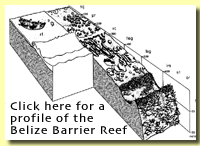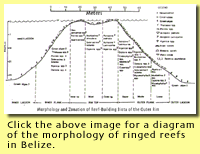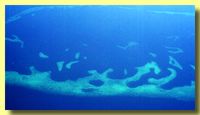

Reef development in Belize consists of 2 major types: 1) a semi-continuous barrier reef; 2) lagoon reefs that occur primarily in the southern portion of the Belize. The barrier reef consists of a shallow water reef crest several meters in width, fronted by a series of coral spurs and sand grooves to the east. The area behind the barrier reef is called the lagoon. The lagoon is dotted with colonies of coral. Lagoon reefs range from small patches several meters across to "ringed reefs" several kilometers long. These lagoon reefs generally consist of steep-sided mounds of coral debris with tops of vibrant, living coral colonies of many different species. While ringed reefs are shaped very differently than other lagoon reefs (i.e. patch reefs, fringed reefs), the structure, function and marinelife are very similar. The ringed reef at Laughing Bird Caye can be divided into three main areas: 1) the outer rim; 2) the inner lagoon; 3) and inner patch reefs. Other types of minor habitats include mounds, spits and the mangrove island of Laughing Bird Caye itself. The outer rim rises on the average 100 feet above the surrounding lagoon floor and is nearly continuous. The outer rim is relatively narrow and has several ridges which project into the inner lagoon. The outer rim can also be divided into three distinct areas: 1) the rim top; 2) the inner flank; 3) the outer flank. The inner lagoon is completely enclosed and reaches a maximum depth of 16 feet. Between isolated reefs and ridges, the floor of the inner lagoon is nearly flat and consists of a fine mud. The most interesting features of the Laughing Bird Faro are the patch reefs and mounds which criss-cross the inner lagoon. Because they are so diverse in size and structure, these inner reefs can also be separated into three categories: 1) reefs attached to outer rim; 2) linked reefs that are attached to each other by deep coral reefs; 3) and isolated patch reefs.
|
|



